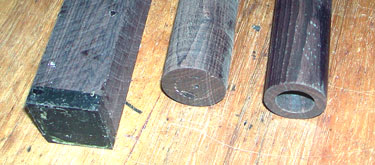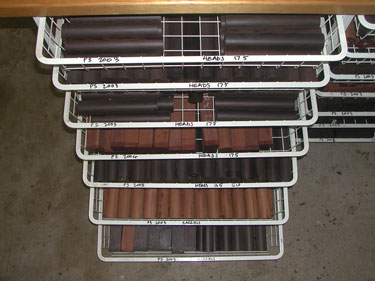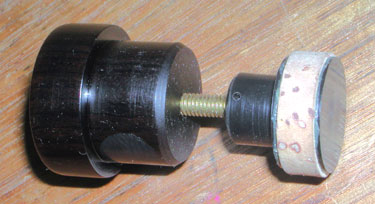How My Wooden Flutes are Made
I've been making wooden flutes for Irish music since the mid seventies.
That's almost 30 years - probably longer than any other current maker - and my
methods and processes have been under constant revision for that entire
time. I've also had the benefit of doing extensive research on the old
instruments, and heaps of repairs on old flutes and flutes by modern
makers. Consequently, I think I've probably looked at every tiny issue
dozens of times, and come to the current processes and methods only after the
most rigorous consideration of the instrument, the materials and the available
technology. My aim at all times is to make the finest flute I can, with
the best materials and the
best methods I can, and
certainly to make instruments that will continue to function as long as there is
a need for Irish flutes.The TimberTimber for wooden flutes is special. It's very fine and very dense - so dense it sinks in water even when completely seasoned. Timbers I use include African Blackwood, Mopane (also from Africa), European Boxwood and a number of Australian timbers principally Gidgee, Cooktown Ironwood and Red LancewoodTimber either arrives in log form or these days more commonly in the form of sticks about 40mm square and of varying length. Logs are cut up into sticks and left to season for as long as possible before use. Some of my timber is 17 years old; I even have one short log of boxwood, a gift from the late Australian recorder-maker, Fred Morgan, marked 1933. To be kept for a special job! Sometimes one can be lucky and pick up some good recycled timber. I
made one of my own flutes from a stump of a shearing shed. The shed fell
down in 1917. In the dry sandy soil around Bourke, New South Wales, the
stump seasoned very well!
Rough boringI use special drills for boring the hole through the middle - "gun drills" -
developed for
drilling the long and very straight bores needed for firearms! Gun drills
are remarkable - they are cunningly ground to have a strong self-centering
instinct - and will routinely come out within fractions of a millimetre at the
other end of a foot-long piece of dense blackwood. I use a range of sizes
- each section of flute timber is bored just a little smaller than the smallest
part of the future bore will be.
That will explain the purpose of the 90-degree plastic plumbing piece.
It collects the particles and feeds them via the black flexible tube into my
dust extraction system. It's normally slid up to the work and slides along
the drill as it enters further. The gun drill can easily take too big a
bite for its own good, and, in this arrangement, is driven and controlled by the
lathe carriage on automatic feed. Storage
Laying OutWhen an order comes in, I lay the flute out. This involves selecting some appropriate timber and trimming it to the various lengths needed for the various sections. Wherever possible, especially with the coloured woods, I make the entire instrument from the same piece, cut and aligned to preserve the grain pattern. Where not possible, I carefully select from the stock available to achieve the best match. Reaming and socket cuttingNext, I ream the bore of each section to its desired shape. Reamers are scraping tools made from drill-quality steel rod. The steel is turned down to the desired shape of the bore on a metal lathe. Then the bar is cut lengthways to just over half way - so now instead of being round it has a D shaped cross section. The edges are sharpened and the reamer is used in the metal lathe at low speed, converting the gun-drilled cylindrical hole to the right shaped bore. Where possible, the sockets are cut by specially made cutters mounted right on the reamers, ensuring sockets and bores are perfectly aligned. Where not possible (eg where a foot is reverse tapered), the socket cutter has a guide to pick up the existing bore to achieve the desired alignment. Nothing is left to chance.
MillingAssuming we're talking about a keyed flute, this is now the time to cut the slots for keys and remove the unnecessary parts of the keyblocks. Pin holes for mounting keys are drilled now too. Keyless flutes are spared these indignities. The old makers would have envied my mill. From what we can determine looking at old flutes, they used stationary scraping tools in the toolrest of a machine lathe to scrape out the slots. Slow, but effective. So much easier and cleaner with a tungsten carbide cutter spinning at high speed. A beautiful tool. External finishingAfter all that, the outside needs cleaning up. Integrating the carved sections with the remaining turned surfaces is a delicate and time-consuming process using a range of tools. The instrument's exterior is then finished with very fine grades of abrasive paper, fine steel wool and a buffing wheel. The Holes
|
Proper holesAfter the milling machine has made the basic holes, the real work on them begins. The all-important embouchure is cut to the desired profile, using a range of hand tools, with the assistance of bright lights and a stereo microscope. You'd be amazed at what you can achieve with a steady hand once you can see what you're doing. I could have been a brain surgeon. But what a waste! Finger and key holes are undercut in various directions to optimise tuning and responsiveness. Sharp edges are taken off the holes, particularly where they meet the bore, to reduce losses due to turbulence. StampingAs the flute is now taking on an identity, and the exterior work is mostly done, I stamp the instrument with my maker's mark and the flute's serial number. The keysThe keys are mostly cast, from models I've forged, in a new and patented alloy called Bright Silver. Although still meeting the specifications of sterling Silver (ie 925 parts per thousand are pure silver), Bright has the very great advantage of resisting fire-scale - a difficult-to-remove tarnish that can affect traditional sterling. Occasionally though, I need to make special keys to suit a particular player's requirements. These I hand-forge (literally hammer and anvil) from rectangular section silver bar, using the old art of metal-spinning on the wood lathe to fashion the cups. (I have to admit to a personal vice here. I found silversmithing really addictive - there is something really enjoyable about forging something intricate and beautiful using such basic tools - that I put off going to casting probably 5 years or more longer than I should have!) The keys have to be fitted carefully to the slots in the blocks, and have pins, springs and stainless steel striker plates made and fitted. I prefer to use leaf springs, as the old makers did, rather than coil springs or needle springs as some modern makers use. Leaf springs, when used correctly (and I'll admit it takes a lot of messing around until you get it right), give by far the snappiest action of any kind of springing. The spring pressure on all other kinds of springing increases (sometimes substantially) as the key is pressed further, whereas on leaf springing, it can actually be made to decrease. Once they are working well, the keys are sanded, polished and buffed in exactly the same way jewellers finish their precious metals. Pre-shrinkingNow we come to a very important part of the process, a development of my own that helps prepare my flutes for any climate. As you probably know, in dry weather wood shrinks, and in wet weather (or after playing in the case of a flute), it swells. There's nothing we can do about that - it's just the nature of the material. What isn't well-known though is that there is a non-linearity - once shrunken and returned to normal humidity, the timber doesn't quite swell back to its original dimension, it remains slightly shrunken. So the carefully reamed dimensions of the bore are no longer accurate. This is one reason why some makers of baroque instruments ask you to return the flute 6 months after purchase so that it can be re-reamed. I take the other approach - I expose the flute pieces to extremely dry climate in a specially made artificial-environment chamber. Essentially, I pre-shrink them, in the same sense that clothing fabrics are pre-shrunk so that they will not shrink on first washing. Simple, but so very important, especially where flutes are going to places where the humidity drops very low for extended periods. Rings and RelaxationThe rings are made up usually from D cross-section silver wire. The metal is cut to length and the pieces bent into a circle and hard soldered. The rings are made round on a mandrel and filed, sanded, polished and buffed to a high finish.A groove is carefully turned on the exterior surface of the flute to take each ring. Interestingly, I still prefer to use the wood lathe and hand guided tools for this sensitive job. The rings are gently tapped into place with a soft faced hammer. Once the rings are in place, the pieces are given some time to relax from their recent ordeals. Final ReamingAfter that dry-weather-induced shrinkage, and the compressive effects of the tightly fitted rings, the bore and sockets are no longer the ideal dimensions we had planned for them. So, time for another reaming. You'd be stunned to see how much material comes off! Clearly, I'm not wasting my time. Investing it in your flute's future rather. TenonsNow that our sockets have assumed their final shape (and because of pre-shrinking are less likely to lose it), we can cut our tenons. This is another task where I prefer the greater sensitivity of hand-guided tools on the wood-lathe. Bore treatmentShrinkage of the bore is one reason I mentioned above that some baroque flute makers ask you to return the flute for re-reaming. The other is the issue of breath moisture raising the grain inside the bore. Minor fogging of the bore finish will not substantially affect flute performance, because air in contact with the wood isn't going to be moving anyway. But if the roughness inside the wood exceeds the "boundary layer" - about 0.1mm (4 thousands of an inch) - it will reduce the efficiency of resonance and therefore the responsiveness of the flute. It's quite frustrating to produce a nice finish in the bore, only to see that become ridgy and rough after a few weeks playing. And it's not just a trick of the eye - the bore becomes distinctly rough to the touch as well. Definitely not nice. After much research and experimentation (including using a CAT-scanner to examine "sections" of bores before and after!) we've worked out why it happens. More than that, we then developed a way to artificially induce and speed up that degradation process so that we now incorporate it in the making of every flute. Once we have completely messed up the beautiful finish inside your flute, we painstakingly rebuild it. Our experiments show that further attack by moisture in playing will no longer roughen the grain to the extent necessary to impair responsiveness. And you can take pleasure in knowing that every time you swab out your flute, you're building a better finish, rather than fighting a losing battle against an increasing degraded one. OilingAnd to reduce further risk of breath moisture attacking the surface of the bore, we give the flute two coats of linseed oil to act as a moisture barrier. Linseed oil isn't favoured by a lot of makers as it takes a lot longer than some other oils to dry. Again after a lot of experiments, we're still of the opinion that it provides the best protection, and will continue to use it until we find something better. Not just quicker. The stopperStoppers in the old days were made from a cork, attached by a wooden screw mechanism to the cap. Unfortunately, the wooden screw threads tended to strip, and moisture eroded the face of the cork making it pitted and irregular. Many modern makers still rely on the cork, but don't provide a screw mechanism for stopper adjustment.
The tuning slideThe tuning slides on old flutes were brass, thinly plated with nickel. They were tightly fitted into the wood, and made the wood crack when it shrunk. Unfortunately, most modern makers continue to use the same outmoded system. Our New Improved Tuning Slides (Mk. IV) are solid sterling sliver and are unaffected by moisture. Forged from silver slugs by the Fluid Force process using a 60 tonne press, the slides are extremely accurate and drawn to maximum hardness to minimise wear. Instead of a tight fit in the wood, the slides are lapped in tenon cork where they join the wood to permit the wood to continue to move with the weather without stress. AssemblySo we've made a pile of bits - now it's time to put them all together. Consider the parts count for a typical 6-key flute:
A grand total of sixty pieces. Plus glues, shellac, oil and grease. Set up and testingEven at this late stage, you can make a difference between a good flute and a great one. The stopper position has to be set right. Pads have to be seated so they seal perfectly. Springs adjusted for ideal spring pressure. The slide must slide but not slip. Tenon corks may need some attention to make them firm but not tight. And I have to be happy if you're going to be happy. I play your flute. The Corner House. The Gold Ring. Kiss the maid behind the barrel. A string of other "big" tunes to seek out weaknesses. And some slow ones to concentrate on note quality. And I check the tuning. Mostly they're fine, but occasionally it might be back to the microscope and scalpel to take out a few offending milligrams from the embouchure. Or a touch-up to spring pressure for a key judged too heavy or too light. Or attention to the undercutting of a hole whose note is not so clear as it should be. Whatever it needs, it will get. Final polishFinally judged done. Like the old Cornish metal worker asked how accurately he could work. "We gets it perfect, and then it's good enough." A final polish of wood and metal, then into its box and on its way. I hope you'll see from the account above that not only have I put a lot of thought into how flutes should be made, but that the process is informed by long experience and private research, and remains under continuous review. I use the best materials, and a best mix of 19th century, 20th century and 21st century techniques to achieve my goals. I am sure that no-one, anywhere, makes a more carefully considered flute. If you're considering buying a flute, ask the makers on your short list how they go about making their instruments. It's a fair question! Back to McGee Flutes home page...
|



